In private homes or on the ground floors of the apartments the floors are always cold. Warming the floor in a private house with their own hands is easy. Read this article and you will be able to do it yourself.
There are several technologies for floor insulation:
With the help of wooden decking, between which a layer of thermal insulation is laid;
Expanded clay screed;
Laying of heating systems.
In this article, we will consider one of the simplest options: the warming of the floor with a mineral wool padded between the lags.
Substrate preparation
The basis for laying the insulation can be anything: concrete or a wooden rough floor. Before starting work, the old coating is completely dismantled. If the wood floor is not rotten, it is processed antiseptic and laid as a rough floor. Antiseptic treated also bearing beams and logs. Under them, a roofing material or other layer of waterproofing is applied.Antiseptic treatment
If there is a lot of moisture in the space between the floor and the basement or the basement, check all the ventilation openings. Begin the installation of insulation should be only after the full drying of the basement: otherwise, it will quickly "pull" the water.
Installation of a lag for mounting a heater
To extinguish the noise of steps before laying the lag is better to lay along the walls marginal bands from strips of mineral wool 2-3 cm. Lags, impregnated with antiseptic, are exposed by means of level with a step on width of a heater of 60-90 sm.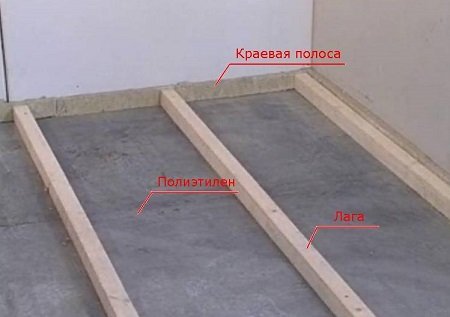
Logging
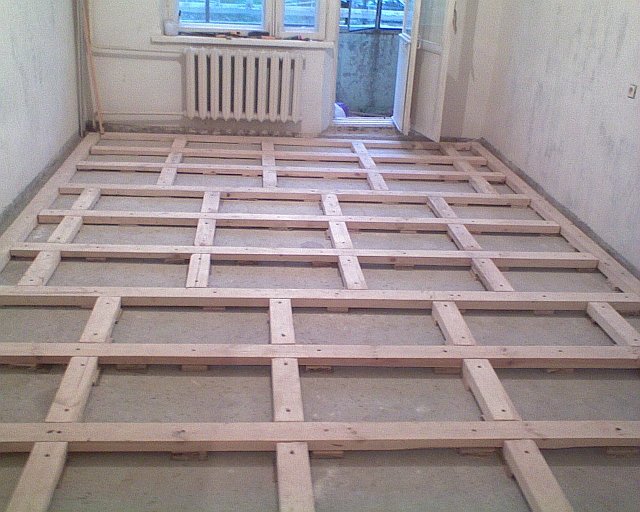
Rims
To strengthen the lag and eliminate squeaks and bends when walking to them, a crate is fastened in steps of up to 50 cm.
Important! To ensure natural ventilation between the layer of thermal insulation and the wooden covering, it is necessary to make an air gap. To do this, you can use high lags or lay on them counter-racks.
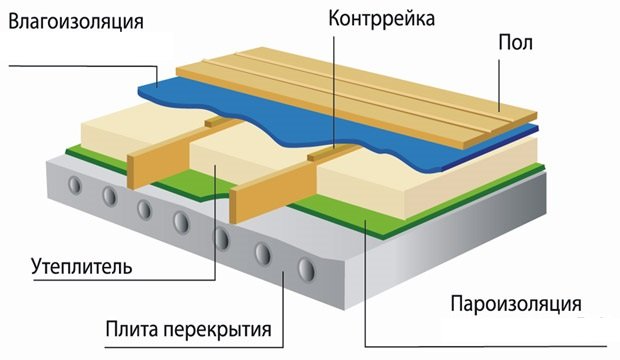
Layout of insulation

Clearance for ventilation
Waterproofing
To ensure that the insulation layer does not become a place of accumulation of condensate and does not damage the structure, it should be provided with protection against moisture. As a waterproofing, polyethylene film, ruberoid, waxed paper, membrane material, etc. can be used. They are laid with the approach to the walls to the height of the future floor without tension, freely. The waterproofing material is overlapped by 10 cm, to ensure tightness joints are fixed with a stapler or a construction tape.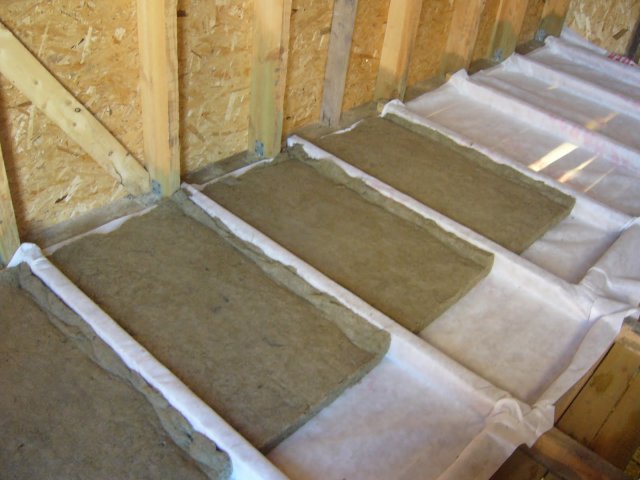
Waterproofing of thermal insulation material
Laying of heat-insulating material
To heaters for the house there are special requirements. In addition to high protective thermal insulation properties, they must have a low degree of fire hazard. Mineral wool - fireproof and a relatively inexpensive material with low thermal conductivity and high strength. Plates of mineral wool for floor insulation should have a sufficient thickness of 5 cm. When installing a heater over heated basements, this figure can be reduced to 3 cm.Important! When laying mineral wool wear clothes and a respirator. Rubber gloves are used to protect hands. It is forbidden to work near food or water intended for drinking.
The insulation is laid as tightly as possible, without voids or tears. The most convenient in the order of minvate in the form of plates. When using rolls, they are stacked lapped. In the places of joints with the crate, the sheets are cut. To ensure a minimum number of seams, it is necessary that there are few such cuts.
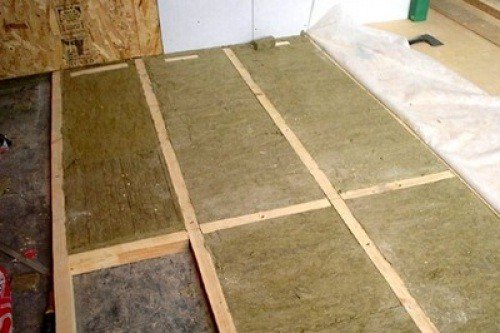
Stacking of mineral wool
Steam insulation
It, as well as waterproofing, fits with the approach to the walls. To reflect the heat coming from the house, you can use an additional layer of foil. Diffuse ("breathing") membranes - a more expensive waterproofing material, capable not only to retain moisture, but also to let in air. It fits membranes to a heater.Boardwalk overlapping
Boarded flooring can be anything: hardboard, OSB, gypsum boards, special plasterboard for the floor or floorboards. Finishing coating can be any. If the laminate is used as it, a moisture resistant plywood is laid under it.Advice! To eliminate noise, the finishing floor is laid on the logs with an indentation from the wall for 2-3 cm.
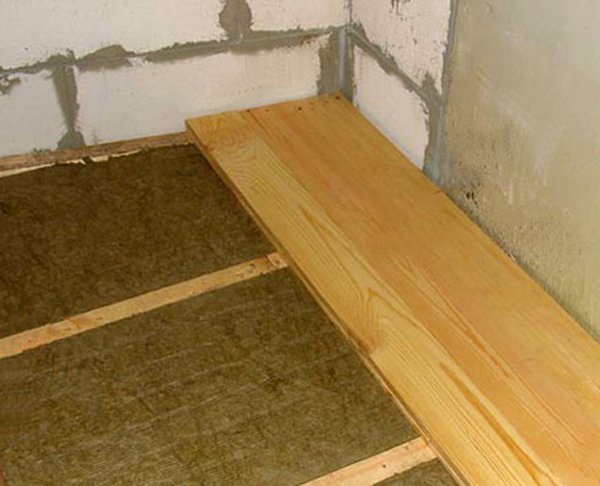
Laying of the wooden floor
Warming from the cellar
If you disassemble the floor is not planned, it can be insulated from the basement floor. The work begins with sealing in the ceiling of cracks and cracks.To protect the insulation from getting wet and forming mold to the covering of the overlap with wooden strips, a vapor barrier with a 10 mm overlap is attached, and then the bars are installed in steps of the size of the insulation. It is mounted between the crate racks or wire mesh. The last layer of vapor barrier is laid.
Important! When closing the lag with a film, 10-15 cm is left on each side for ventilation. That in places of a joint of a ceiling with a wall there were no bridges of a cold, a heater put on the wall at a distance of about 5 cm.


Laying of thermal insulation from the cellar side
Watch the video: how to insulate the floor in a private house
Laying the floor in the construction of a private house is an extremely important and responsible stage, because the humidity and temperature in the room depend on it, which should be comfortable. Correctly arranged wooden floor in a private house will retain heat and will withstand any daily workload, therefore it is not necessary to save much on flooring materials, it is normal to spend 20-25% of funds from the total budget.
Types of floor construction
With all the variety of projects in private homes, there are not many options for flooring:
- Wooden floors;
- Floors on concrete base;
- Combined floors with wooden flooring on a concrete cushion.
Often the owners of private buildings try to make a basement, which performs several functions at once:
- ventilation under the floor in a dwelling;
- an increase in the useful area in the basement, which can be used for technical purposes to install a heating boiler or a water pumping station;
- creating conditions for storing seasonal blanks and vegetables in connection with the constant cool air temperature in the basement.
Many try to do in the basement carpentry shop or sports department with the installation of horizontal bars and simulators. The quality of the floors in the basement will provide a warm, dry microclimate, which will have a beneficial effect on the health of the inhabitants of the house. Before beginning the laying of the foundation on the black ground, groundwaterto avoid spring leakage in the basement.
Wooden floors are mounted in single or double-layered form, when in the beginning it is customary to make a rough-insulated basement, and on top to lay the finishing boards. Single floors are suitable only for use in warm weather, so they are best done in summer cottages where year-round living is not provided. In order for the wooden floors to last long and without criticism, it is necessary to make a quality foundation. To begin with, ground the ground and in a certain interval raise the supporting columns, built of bricks and cemented with cement mortar. Brick columns are covered with a waterproofing agent in several layers, for example, a roofing material, and the beams are laid on them, and then lags (crossbeams) on which boards are laid.
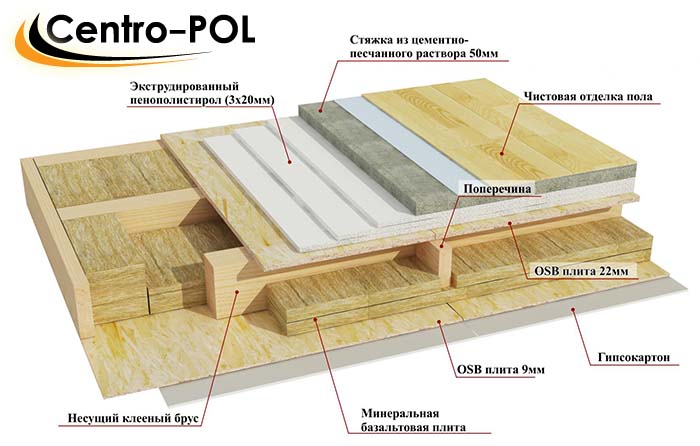
Two-layer floors with a heater can be made using the technology shown on the video:
- lay the beams on the brick supports and fix them with corners and screws;
- to lay rough floors on the beams, for which non-wood boards of coniferous wood are used, which are fixed with screws;
- isolate rough floors from penetration of moisture can be a polyethylene film, the fabric of which is overlapped and glued with adhesive tape;
- lay the beams and fill the space between them with a heater (expanded clay, mineral wool);
- to establish finishing floors and final floor coverings, among which parquet, laminate, linoleum, carpet, ceramic tile.
For laying the floor, you can use sheet-shaped boards that tightly adhere and leave almost no gaps. The boards of the finishing floor should be laid perpendicularly with respect to the planks of the rough floor. A shortened sheet pile is called a massive parquet board, which can be laid obliquely diagonally, giving the room a catchy, individual character.
Important! All wooden elements must be impregnated with antifungal antiseptics and flame retardants (fire-resistant substances). This should be done to protect the tree and extend the life of the tree.
Construction of concrete floor
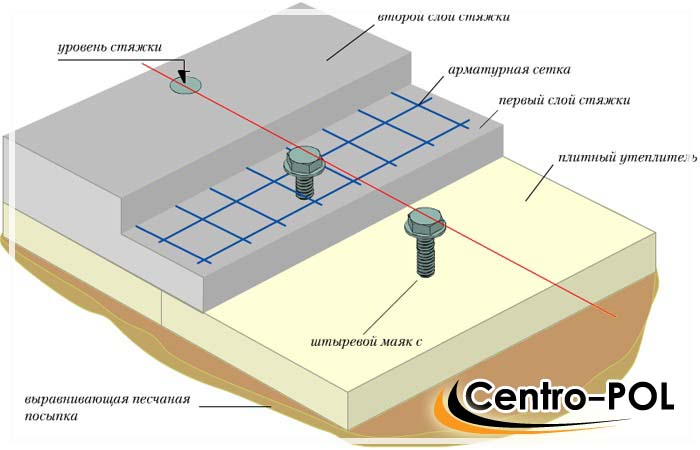
Concrete floors without wooden flooring in private houses are practically not made, in the southern climatic zone the concrete base is covered with wooden flooring without a heater. As shown in the video, it is recommended to do floors on a concrete base, following the following steps:
- level the soil and pour a layer of sand 10-15 cm high, which must be poured with water and tamped;
- pour on top of soil with sand rubble of middle fraction 10 cm high and also compact;
- make a rough concrete screed, it is possible with the addition of expanded clay or foam plastic chips;
- lay a layer of waterproofing, for which you can use polyethylene film or roofing paper;
- distribute the layer of insulation - expanded clay or extruded polystyrene foam;
- decompose the metal reinforcing mesh, which should be filled with a screed;
- make wooden floors using beams and boards;
- lay flooring.
Do concrete floors with a wooden coating much longer and more costly, but it pays for itself by a long period of operation without repair. Instead of finishing the concrete screed and laying the floorboards, you can use the technology of a dry screed, for which you need to make guiding rails, padded with insulation and sheets of plywood, fiberboard, chipboard, gypsum-fibrous sheets, GKL (gypsum-cardboard sheets), MDF, OSB. All of the listed materials are durable, easy to saw and well-supported, on top of which you can lay any floor covering. This technique allows you to significantly reduce the cost of building materials and time spent on finishing the floor.
When constructing floors in the basement, the owners are particularly concerned about how to protect it from the effects of freezing ground and high humidity. The best solution is to fill the monolithic slab at the stage of the foundation installation from scratch, which is described in detail in the video.
Monolithic tile foundation - an indispensable option for the construction of a private house on a site with "complex" soils, prone to flow and displacement. These factors do not completely affect the position of the monolithic tile foundation, and, therefore, the walls of the house will not be deformed either. When laying such a foundation, immediately it turns out to make a reliable floor base, on which it is possible to lay beams with insulation and boards or any sheet material.
An even more promising way to do monolithic foundation - Order the installation of a factory reinforced concrete hollow core slab, which will give the whole structure an indestructible strength. These plates are made of concrete with embedded iron reinforcement and through them longitudinal hollows of a rounded shape run.
Important! Reinforced concrete slabs are adapted to withstand almost any load and are combined with a variety of materials for erecting walls at a private house.
Before placing a reinforced concrete slab in the basement basement or the basement floor, it is necessary to level the ground and make a low formwork for a thin concrete screed in order to obtain a flat horizontal surface. Seams between the slabs are filled with cement mortar and wooden floors can be laid on the surface of reinforced concrete slabs.
It is better to do all calculations not by yourself, but to entrust to the specialist-designer, because even a slight distortion or non-observance of technological norms can lead to irreparable consequences. We will admit, at the device of floors in the private house the area more than 100 sq. M. m. The usual pouring will take a lot of time and financial costs will significantly exceed the cost of shipping reinforced concrete slabs.
System "floating floors"

The device of interfloor overlapping must necessarily correspond to the increased requirements of soundproofing, so that music or laughter on the second floor does not interfere with the inhabitants of the house on the first. Both air and shock noises (jumps and falls) through the overlap are transmitted to neighboring rooms and are capable of delivering discomfort. To avoid this, it is possible to make a design using the "floating floors" system, which have a multi-layer structure, but do not touch the walls, so it is better to absorb sound waves.
Create a cozy and comfortable atmosphere in the house is much more difficult than it seems. Low temperatures, cold floors and drafts are problems that many owners of private houses have to face. The better the insulation, the lower the cost of heating - this rule has long been known. But how can you make your home more protected and warm? First of all you need to take care of the sexes. Remember how unpleasant it is to step on the icy cold, how your feet freeze when sitting in the armchair in the living room for a long time ... All these symptoms of insufficient warming of the floor can be eliminated in just a few hours. In this case, you do not need to seek help from professionals. With such work, even the most inexperienced "home master" can cope.
What and how to insulate the floors?
Choosing the right material is not an easy process. We recommend that you initially compile list of requirements for insulation. For example, the thickness, the need for waterproofing, the complexity of installation and so on. It is also necessary to take into account purpose of the room: for the kitchen, bathroom and bedroom, you can choose different materials to achieve the ideal insulation. But what properties do heaters have? What are their similarities and differences?
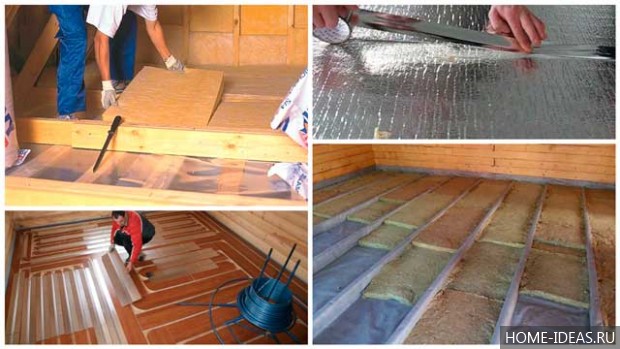
Expanded polystyrene, extruded
One of better options for insulation of floors in a private house. This modified form of expanded polystyrene differs from its predecessor in a more closed structure. This dense and durable material is suitable for warming floors on the ground, besides it does not require a special base of concrete. Extruded polystyrene foam can be laid directly on gravel or expanded clay.
Advantages of this material:
- minimum moisture absorption,
- high level of thermal insulation,
- strength,
- soundproofing,
- reliability,
- resistance to various biological organisms,
- stability of size and shape,
- simplicity of installation.
And yet there is one obvious flaw, because of which this type of expanded polystyrene is not very popular - high price.

Styrofoam
But the price for this "simple" form is much lower. Almost all the advantages of the previous instance have been preserved. Thermal conductivity practically does not differ, hygroscopicity also. The only explicit " minus» polystyrene is a low strength. Sheets can break during delivery and installation, they can be affected by extreme loads (heavy furniture in the room). Do not recommend you use a similar insulation for the garage and other rooms with a high load on the floor.

Polyurethane foam
Modern technologies allow to receive a heater with the necessary qualities directly on the construction site. For this purpose, it is sufficient to mix only two liquid components. The final result will be a solid polymer.
Properties of polyurethane foam:
- low thermal conductivity (inferior to it and expanded clay, and mineral wool),
- high resistance to chemicals,
- excellent sound insulation,
- low combustibility,
- low moisture absorption (depends on the density of the material).
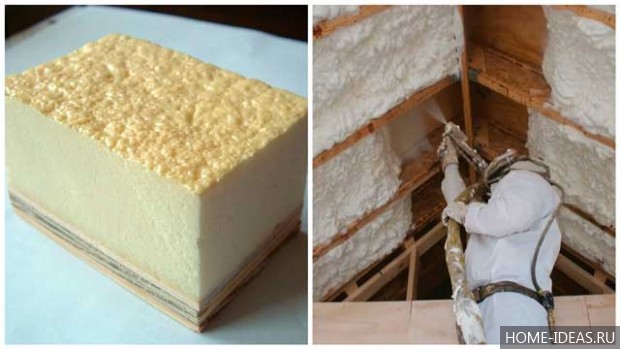
Mineral wool
This material is considered the most popular type of insulation. There are many reasons for this:
- low thermal conductivity,
- good sound insulation,
- resistance to moisture and fire,
- relatively low cost,
- long life time,
- compliance (relevant for strong mechanical effects).
Lack of mineral wool only in the installation: not very complicated, but quite troublesome. In addition, this material will require a suitable basis.
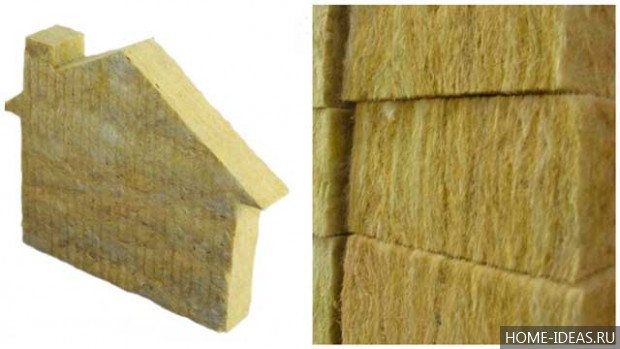
Expanded clay
An excellent choice for those who want to insulate the floor once and for many years. Among merits of expanded clay especially stand out:
- durability,
- resistance to high and low temperatures (does not lose its qualities and does not collapse),
- fire resistance,
- excellent sound insulation,
- low thermal conductivity.

Warming the floor in a private house with your own hands: step by step instruction
Modern technology of floor insulation assumes a consistent performance of the following actions: preparation of the base, laying waterproofing, creating and laying insulation, as well as finishing. This work will take time, take your time, and do not change the order of actions.
Preparation
It is necessary to determine the surface relief and the required height of the future floor. To do this most easily with the help of an optical or laser level. Then you can proceed to compacting the soil.
A sand layer forms above it. It must necessarily be slightly higher than required (the allowable rate is up to 25%). The sand is rammed, then moistened and rammed again. The quality of this work will determine the longevity of the floor and its appearance, so we recommend that you take special care to complete this stage.
And then the last layer is laid-clay or gravel.

Waterproofing layer
Through waterproofing materials the future floor is protected from moisture. Also it will help to make a strong black screed. With this stage there will be no special problems. The material is overlapped to avoid gaps. All joints must be fastened with building tape. Be careful, cuts, holes and other damages in the material are unacceptable.
Also remember that the insulation is stacked with a small margin. The edges should rise along the walls by 20-25 centimeters. You can remove surpluses at the final stage.
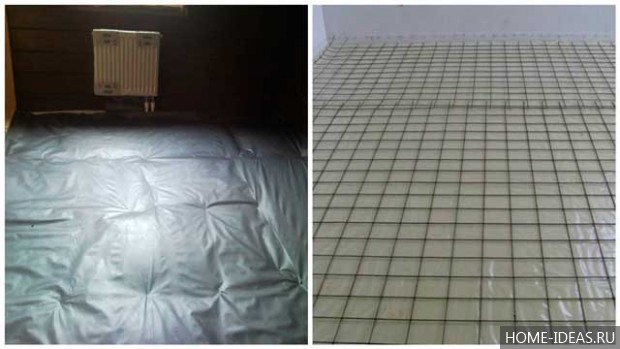
Rough screed and laying insulation
A mixture of concrete and rubble will serve as another layer, which is laid on the waterproofing layer. It should be low (about 50 mm) and relatively flat (permissible elevation difference - no more than 4 mm). Low requirements allow you to make this layer quickly, but still it must completely dry out when the heater is laid.
The method depends on the particular material. Remember that some heaters may require additional vapor barrier.
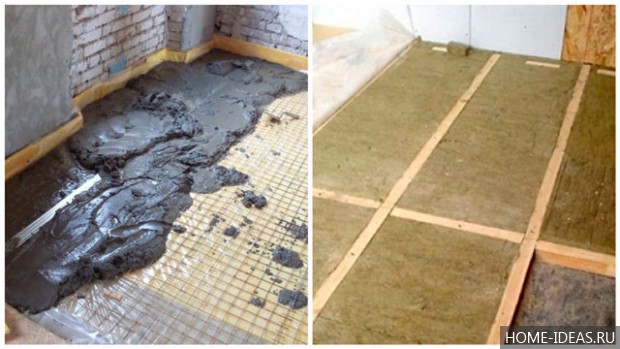
Fine finishing
After this comes the turn of the screed. It must be treated with care. You can use both the usual monolithic jellied, and a dry or semi-dry screed.
In the classical version, horizontal rails are installed on the floor, which mark the desired height of the floor. "Lighthouses" are leveled by means of a building level. Sand and cement mixture Fits on the floor and is aligned "by beacon" rule.

